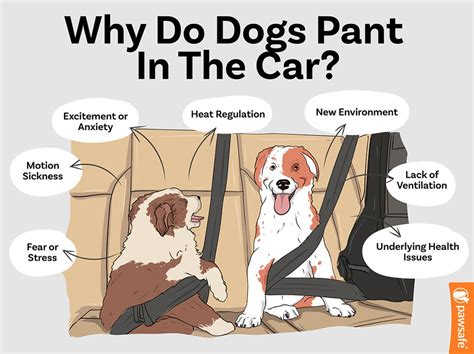Discover the reasons behind your dog's panting during car rides and learn effective strategies to help them feel more comfortable and relaxed on the road.
I remember the first time I took my beloved golden retriever, Luna, on a long car ride. Excited for our adventure together, I packed her favorite toys and treats, hoping to make the journey enjoyable for both of us. However, as soon as we hit the highway, Luna began panting heavily, her tongue lolling out of her mouth as she struggled to catch her breath. Concerned for her well-being, I couldn't help but wonder: why do dogs pant in the car?
As a dedicated dog owner and writer for barkneywick.com, I've since learned that panting dog in car is a common issue faced by many pet parents. Through my own experiences and extensive research, I've discovered that there are several reasons why dogs might exhibit this behavior during car rides.

Reasons Behind a Dog Panting Car Ride
1. Overheating and Temperature Regulation
One of the primary reasons why dogs pant in the car is to regulate their body temperature. Unlike humans, dogs have limited sweat glands, so they rely on panting to cool down when they feel too hot. In a car without proper ventilation or air conditioning, your furry friend may start panting to combat the rising temperature and maintain a comfortable body temperature.
2. Excitement and Anticipation
Some dogs, like Luna, associate car rides with exciting adventures, such as trips to the park or beach. This anticipation can lead to an increased heart rate and panting as they eagerly await the fun that lies ahead. While this type of panting is generally not a cause for concern, it's essential to ensure that your dog doesn't become overly excited or stressed during the journey.
3. Anxiety and Stress
For some dogs, car rides can be a source of anxiety and stress. This may be due to unfamiliarity with the vehicle, negative past experiences (such as trips to the vet), or a general fear of the unknown. When a dog is anxious, they may exhibit panting alongside other stress-related behaviors like shaking, whining, or drooling.
4. Motion Sickness and Nausea
Just like humans, dogs can experience motion sickness during car rides. This can cause them to feel nauseous and uncomfortable, leading to panting as a coping mechanism. If your dog is prone to motion sickness, you may also notice other symptoms such as drooling, lethargy, or a dazed expression.
5. Overstimulation and Sensory Overload
For highly attentive dogs or those from herding breeds, the sights and sounds of traffic or new environments can be overstimulating. As they process this sensory overload, they may begin to pant as a way to cope with the excess stimuli. This type of panting is more likely to occur in dogs that are not accustomed to frequent car rides or those that are particularly sensitive to their surroundings.
Addressing Your Dog's Panting in the Car
Now that we understand the various reasons behind why dogs pant in cars, let's explore some effective strategies to help your furry friend feel more comfortable and relaxed during car rides.
1. Ensure Proper Temperature Control
To prevent your dog from overheating, make sure your car is well-ventilated and maintains a comfortable temperature. Use air conditioning when necessary and consider opening the windows slightly to allow for fresh air circulation. Avoid leaving your dog in a parked car, as temperatures can quickly become dangerous, even on mild days.
2. Create Positive Associations
Help your dog develop positive associations with car rides by taking them to enjoyable destinations, such as the park or a favorite hiking trail. Reward calm behavior with treats and praise, and gradually increase the length of car rides as your dog becomes more comfortable. By creating a positive experience, you can help reduce any anxiety or stress your dog may feel during car trips.
3. Implement Desensitization Training
If your dog's panting stems from anxiety or fear, desensitization training can be an effective solution. Start by allowing your dog to explore the car while it's stationary, rewarding them with treats for calm behavior. Gradually progress to short trips around the block, slowly increasing the duration and distance over time. Consistency and patience are key in helping your dog overcome their car-related anxiety.
4. Address Motion Sickness
For dogs that experience motion sickness, consult with your veterinarian about potential treatments or medications that can help alleviate symptoms. Some natural remedies, such as ginger or lavender, may also provide relief. Additionally, limiting food intake before car rides and using a secure, comfortable harness can help minimize nausea and discomfort.
5. Plan for Regular Breaks
On longer car trips, be sure to schedule frequent breaks for your dog to stretch their legs, hydrate, and relieve themselves. This not only helps reduce stress and discomfort associated with being confined for extended periods but also allows your dog to take a break from any overstimulating sights and sounds.
The Road to a Happier, Healthier Car Ride
As I reflect on my journey with Luna and her car-related panting, I'm grateful for the knowledge and understanding I've gained along the way. By recognizing the reasons behind her behavior and implementing strategies to address her needs, we've been able to transform car rides from stressful ordeals to joyful adventures.
For fellow dog lovers and readers of barkneywick.com, I hope this article has provided valuable insights into why your dog may pant in the car and how you can help them feel more at ease during your travels together. Remember, every dog is unique, and what works for one may not work for another. Be patient, observant, and willing to try different approaches until you find the solution that best suits your furry companion.
With a little understanding, patience, and love, you and your dog can embark on many happy, pant-free journeys together, creating cherished memories along the way.
